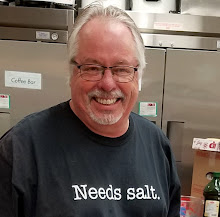The confit experiment I wrote about in my last post came out well, I think. The venison came out of the oil after two hours at 300 degrees and was thoroughly cooked and fairly tender. I was fairly conservative with the spices and salt so it was not terribly flavorful, but then again it was an experiment to test the cooking technique. I have looked up some recipes for duck confit to see a comparison of technique and find it is done on the stove top in a dutch oven over low heat for about the same time (2 hours) and then left in the fat for storage. That corresponds with Hal McGee's description of the ancient use of the system for storing cooked meats. the duck will keep for months in the fat layer and just needs to be reheated in an oven or in a particular dish which it is being used.
I sliced my cold venison confit very thinly and warmed it in a beef jus that I had saved in the freezer which had some pureed roasted onions in it. I then made some mashed baby red potatoes to serve it over and fried some leftover walleye cheeks from the wild game dinner which hadn't been cooked yet; kind of a surf-and-turf deal. The walleye was dredged in very well seasoned flour, dipped in beaten egg, then in Panko bread crumbs and fried in a combination of butter and vegetable oil. the walleye was excellent and the venison was much improved by combining it with the beef jus. Overall I think it was a success.
I think I'll try the same system using the dutch oven and much more seasoning next time as it will be much easier to do on the stove top. By the way, I had covered the baking dish in the first attempt with plastic wrap and then foil. I found in opening it up at the end of cooking that the plastic wrap was a wasted step as it disintegrated under the foil. That combination works well with meat in a braising liquid in the oven to keep moisture in but apparently the oil was too hot or somehow degraded the plastic wrap to nothing. It was a good lesson learned.
On another front, my friend Steve Rudh and I brewed our first batch of beer yesterday. We chose an Irish Red Ale as our first project. It was a fun evening of reading instructions, sanitizing brewing equipment and boiling the wort. The whole process took about 3 1/2 hours from start to finish and was not difficult at all. I had been studying the possibility of brewing for a while and on Teresa's and my culinary adventure trip a couple of weeks ago we went to Northern Brewer (www.northernbrewer.com )store on Grand Ave. in St. Paul and purchased the basic brewing equipment, the Red Ale kit and some liquid yeast. The folks at the store were very helpful in going over the whole process with us and getting us the right equipment to start out. They also told me to call anytime during the process of brewing with questions and they would be glad to answer and be of help.
I am happy to report that as of this morning the airlock on the fermentation bucket is bubbling away which means that we have fermentation going on. that should last for about two weeks or so and then we'll test with the hygrometer to see if the specific gravity is stable ( that means it's done fermenting). At that point we transfer to the bottling bucket and make about 48 bottles of a hopefully lovely Red Ale. It has to sit in the bottles for about two more weeks to produce the carbonation and then we refrigerate and sample! I am excited about this! I'll tell you all about it when the day arrives.
Tim
Thursday, March 18, 2010
Subscribe to:
Post Comments (Atom)

No comments:
Post a Comment